Theme Parks & Themed Entertainment
Did Disneyland inspire the Universal Studio Tour in Hollywood? Or was it actually the other way around?

What with James Cameron's tour of Disney's Animal Kingdom on
October 17th (which was then followed by this Academy Award-winner's
visit to Universal's Island of Adventure on October 18th), the Web
has once again been a-buzz with stories about how The World of Avatar is
supposed to be Mickey's answers to The Wizarding World of Harry Potter. More
importantly, how Disney's now-decades-long grudge match with Universal shows absolutely
no sign of abating.
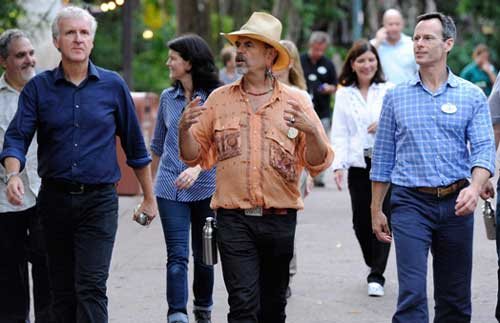
(L to R) James Cameron, Joe Rohde and Thomas Staggs on a walk-thru of Disney's
Animal Kingdom. Copyright Disney Enterprises, Inc. All rights reserved
Well, while it is true that things have been a bit testy
between these two media giants ever since February of 1985 (which was when
Michael Eisner revealed his plan to add a studio tour to WDW's
assortment of attractions. Which would then put the Mouse in direct competition with
that movie-based theme park which Universal had been planning on building in
Orlando since back in 1979). But these two mega-corporations weren't always mortal
enemies. In fact, there were times over the past 90 years when relations were
downright cordial between Disney & Universal.
Mind you, that's probably because – back when he was still living
in Kansas City – Walt Disney used to be a newsreel stringer. Which meant that –
when there was some local event worth noting (EX: hundreds of Shriners parading up Petticoat Lane as their
annual convention drew to a close) – Walt would then grab his camera and then get
some footage of the event. Which — being the enterprising young man that he
was — Disney would now try to sell to Kansas City theater owners so that they
could then add a little local color to their nightly presentation.
And Walt was able to do this enough times (i.e. selling
live-action footage that he'd shot around town. Most notably to the movie
theaters that were affiliated with Selznick Studios & Universal Pictures)
that he actually had some business cards made up which stated that Disney was the
official Kansas City rep for Selznick & Universal's newsreels.
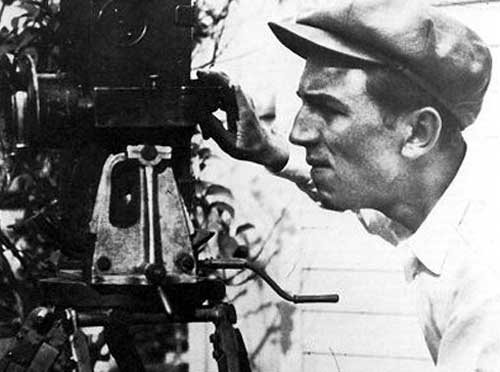
Copyright Disney Enterprises, Inc. All rights reserved
Which obviously wasn't true. But given that Walt was hoping
to someday make a name for himself in Hollywood, a town whose currency is hype
& hyperbole … I guess we can overlook the fact that this then-22-year-old
inflated his resume.
Now let's jump ahead to August of 1923. When Walt is
actually out in Southern California, actively trying to break into the
biz. And since the only way that a new kid in town like him will ever get
a really-for-real movie producer to look at his work is by "accidentally"
bumping into them on the studio lot … Well, that's what Disney decided to try & do.
So clutching his completely bogus
official-Kansas-City-rep-for-the-Selznick-and-Universal-newsreel business
cards, Walt catches the trolley for the San Fernando Valley and soon finds
himself outside the gates of Universal Studios. Where – after presenting
his business card and slinging a fine line of bull at the guard who is manning that
gate – Walt is then given a lot pass. Which basically allowed this future movie
mogul to wander the length & breadth of Universal City.
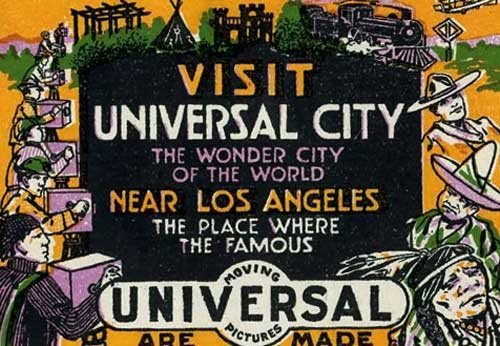
Copyright Universal Studios, Inc. All rights reserved
Now let's pause for a moment here to put ourselves in Walt
Disney's shoes: You're a kid just in from Kansas City. You're always dreamed of
someday making the trip to Hollywood and then getting the chance to make
movies. And you've just now managed to con your way onto the lot of one of the
biggest, busiest studios in town.
Harrison "Buzz" Price (i.e. the Disney Legend who – in his
role as a research economist – helped Walt pick the site of Disneyland in 1953
and Walt Disney World in 1963) once told me about a conversation that he had
with the Old Mousestro while the two of them were on the Disney corporate plane
in the early 1960s. If I remember correctly, Buzz and Walt were flying out to
the East Coast to take part in some meetings related to the 1964 New York
World's Fair when they had this chat.
Anyway … Over a couple of Scotch Mists, Disney started
reminiscing about his early, early days in Hollywood. In particular, Walt began
talking about the days that he spent wandering around Universal City.
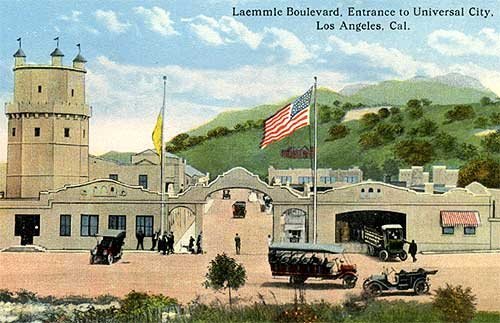
Copyright Universal Studios, Inc. All rights reserved
And – yes – I said "days." According to what Disney
reportedly told Price, Walt spent three days exploring the Universal lot
until the guard at the front gate finally got suspicious and made him
surrender his pass. And while Disney did spend a lot of time while he was on
that lot knocking on doors, trying to get producers & executives to look at
his "Alice Comedies" proof-of-concept reel, Walt also spent much of those three
days wandering from set to set, looking in on Universal's various production
teams as they worked.
And as Price listened to Disney describe it was to be
walking down one of Universal's western sets and then turn a corner &
suddenly find yourself in 15th century Paris, on the massive outdoor
set that Universal's artists & craftsmen had just built for Lon Chaney's "The Hunchback Of Notre Dame" … Well, it then occurred to Buzz that those three days
that Walt spent exploring the Universal lot obviously had a strong influence on the
look & feel of Disneyland.
Of course, what's kind of ironic about this particular story
is that – back in early 1955 – when the bankers were quizzing Roy O. Disney
about what the Company's contingency plans were if Disneyland failed to catch
on with the public, Roy reportedly replied with "We'll just shoot our movies
& TV shows out here. We'll also rent the place out to other production
companies. They can shoot their westerns in Frontierland and medieval adventures out in
front of the castle. We'll figure out a way to make some money off of this
place."
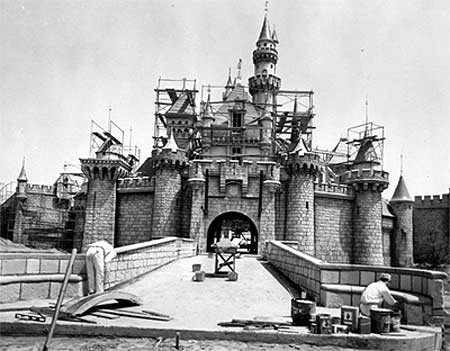
Construction of Sleeping Beauty Castle nears completion in the Spring of 1955.
Copyright Disney Enterprises, Inc. All rights reserved
So if Disneyland hadn't succeeded, it might have then become
the Anaheim equivalent of Universal Studios. Which – come to think about it –
is actually what happened in April of 1962. Which is when Walt allowed director
Norman Jewison and a film crew from Universal to spend two weeks shooting in
& around the Happiest Place on Earth for the Tony Curtis comedy, "40 Pounds of Trouble."
But I'm kind of getting ahead of myself here … So let's get
back now to Walt Disney and his ties to Universal Studios. Which – as the 1920s
continued on – just got stronger & stronger.
To explain: After the "Alice Comedies" had kind of run their
course, Walt created a new cartoon character — Oswald the Lucky Rabbit
– which
he hoped to then build a new series of animated theatrical shorts around. Disney and
his team created a prototype "Oswald" cartoon, "Poor Papa," which Charles Mintz
(i.e. their "Alice Comedies" producer) was then able to get screened for
Universal Studios founder Carl Laemmle.
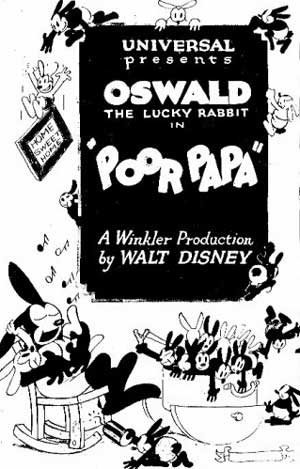
Copyright Disney Enterprises, Inc. All rights reserved
And Laemmle – who was anxious for Universal to have a cartoon series of its own
that could compete against the then-hugely popular "Felix the Cat" and "Koko the Clown" animated theatrical shorts – agreed to take Oswald on. But only
after Carl had given Charles & Walt extensive notes about how to they could
improve the appeal of this character (EX: make Oswald younger & less sloppy
and fat). The second Oswald cartoon, "Trolley Trouble" sealed the deal. Mintz
& Disney then signed a deal with Laemmle which promised that they'd produce
26 "Oswald the Lucky Rabbit" cartoons which Universal Pictures would then
release.
And throughout much of 1927 & 1928, Walt Disney was
reportedly very happy with this deal. Not only because the "Oswald" series
quickly became a hit with moviegoers. But also because the animated shorts that
Walt and his team were producing were being released by a major studio like
Universal Pictures. Which — to Disney's way of
thinking — meant that he'd finally made the big time in Hollywood.
But then – of course – this all came crashing down in the
Spring of 1928, when Walt (buoyed by "Oswald" 's box office success) traveled
to New York City with the hope that he could then persuade Charles to not only give
the Disney Brothers Studio team a raise but also increase the production budget
of the next round of "Lucky Rabbit" cartoons. But Mintz had another idea in
mind. For he actually proposed a 20% reduction in the amount of money that Disney & his
crew was spending on each "Oswald" cartoon.
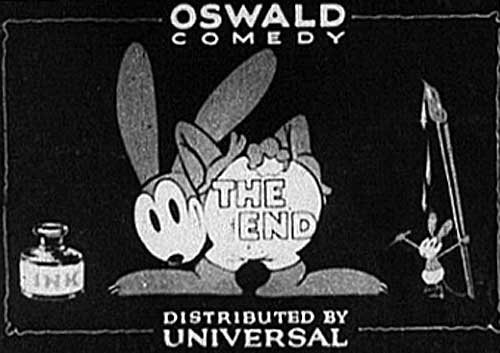
Copyright Disney Enterprises, Inc. All rights reserved
When Walt balked, Charles advised him to take a look at his
contract. Which then revealed that it was Universal – not Disney – who actually owned
the rights to the Oswald-the-Lucky-Rabbit character. What's more, Mintz had
secretly hired away most of the animators that worked for Disney Brothers
Studio. Leaving Walt with very few cards to play in this genuinely awful
situation.
Of course, as any Disney history buff can tell you, it was
directly after this meeting in NYC with Mintz – on Disney's long sad train trip
back to Hollywood — that Walt initially dreamed up Mickey Mouse. So this story
has kind of a happy ending. Kind of.
But from a history point of view, where this tale gets interesting is that – while Disney
despised Charles Mintz for his underhanded dealings in the "Oswald" situation –
he bore no ill will against Carl Laemmle & Universal. After all, Walt had willingly
signed the contract for that cartoon series. More importantly, it was Disney's
own fault that he hadn't read the fine print and learned that it was Universal
Pictures, rather than Disney Brothers Studio, that retained all rights
to the Oswald-the-Lucky-Rabbit character.
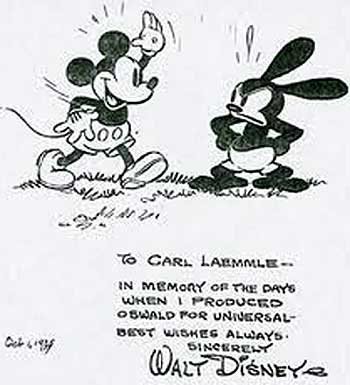
Copyright Disney Enterprises, Inc. All rights reserved
But as Walt was famous for saying: "You may not realize it
when it happens, but a kick in the teeth may be the best thing in the world for
you." And the hard lesson that he learned in the Spring of 1928 helped shape the
way that The Walt Disney Company deals with intellectual property. Even today,
Disney's attorneys are famous for the convoluted contracts that they craft. Which then virtually guarantee that the Company retains the rights to any &
all characters which the Studio's employees create.
Of course, back when he was working in the 1920s &
1930s, Walt had absolutely no idea that the characters – more importantly, the
films that his studio was creating — would have the shelf life that they
enjoy today. Believe it or not, Disney actually assumed that the animated
features which his Company was producing would be like all of the
other movies that Hollywood was producing at this time. In that they could only be
released theatrically once … And after that … Well, that was pretty much it.
According to Neal Gabler, the author of "Walt Disney: The Triumph of the American Imagination," what changed Walt's attitude on this
matter was 1930's "Dracula" and 1931's "Frankenstein." Or – rather – the huge
amount of money that Universal Studios made when they repackaged these classic
horror films as a double feature and then sent them back out into theaters in
1938.
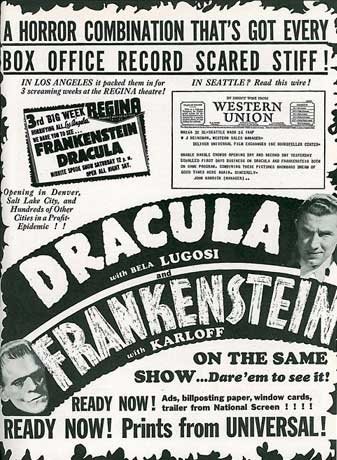
Copyright Universal Studios, Inc. All rights reserved
Mind you, Walt didn't look at that "Dracula / Frankenstein"
double bill and then – all on his own – come up with the idea of putting past
Disney hits like "Snow White" and "Pinocchio" back in theaters. According to
Gabler, it was an WWII-era encounter with a Universal executive that actually
set those wheels in motion:
While coming back on the train from one of his Washington
trips in 1942, (Walt) had met Nate Blumberg, the head of Universal Pictures,
who had told Walt how Universal had mined its old film library for pictures
they could reissue and advised the Disney Studio to do the same. Walt (then)
prodded Roy on this matter, asking him to consider re-releasing Snow White and
possibly some of the other features for Christmas in 1943. Roy finally agreed
on Snow White, though the Company missed the holiday season and opened it
instead in February 1944.
And it was this one change in attitude, thinking of the films
that Walt Disney Studios produced not so much as dairy products (i.e. things
that had a limited shelf life, that you used once and then discarded) but – rather – as
long-term assets which then allowed the Mouse Factory to make it through the
late 1940s & early 1950s. When television suddenly arrived on the scene and
the movie game changed forever.
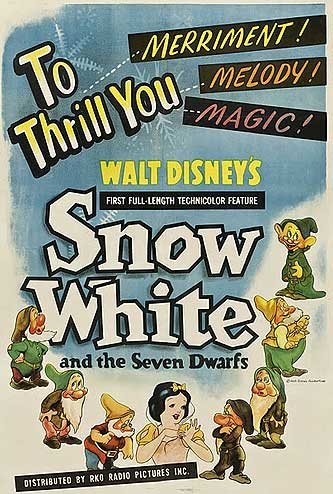
The poster for the 1944 re-release of "Snow White and the
Seven Dwarfs." Copyright Disney Enterprises, Inc.
All rights reserved
And helping Walt through this extremely tumultuous time in
the entertainment industry's history was Jules Stein, the head of the Music
Corporation of America AKA MCA. So when the Old Mousetro began thinking about
getting into television in 1952 (to help finance the construction of
Disneyland), it was Stein who helped open the doors for Disney at CBS, NBC and
ABC. And if the stories that Company old-timers have told me are true, Jules
not only brokered the deal for American Broadcasting executives (which – in exchange
for producing a weekly "Disneyland" TV series for ABC – Walt got $500,000 in
cash as well as $4.5 million in loans which he could then use to fund the
construction of his project in Anaheim), Stein also got MCA to kick in a little
seed money for that theme park as well.
And Walt never ever forgot about how helpful Jules had been, the
key role that this Hollywood mover-and-shaker had played when it came to moving
Disney Studios to the next level. Not to mention how personally helpful Stein
had been towards the Disney family (EX: when Roy E. Disney graduated from
Pomona College in 1951, Jules had the then-president of MCA, Lew Wasserman,
call around and find Walt's nephew a job in the industry. Which is how Roy E.
wound up at a page at NBC).
Which is why – after MCA had merged with Decca Records in 1962 and thus became
the owner of Universal Pictures as well as of that studio's 423-acre backlot –
Walt was pleased to get a call from Jules. Asking him to come over the hill so
that these two studio heads could then go for a stroll around the Universal
lot.
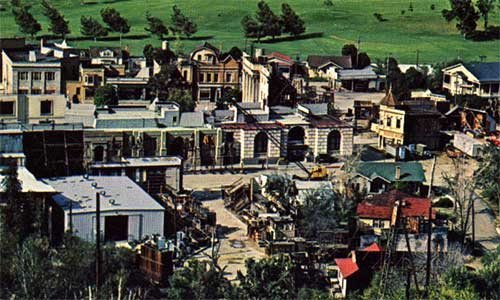
Copyright Universal Studios, Inc. All rights reserved
Now as Buzz Price told me this story, as Jules walked with
Walt around the backlot, he explained that he wanted to pick Disney's brain.
You see, MCA was toying with the idea of reviving Universal's studio tour
(which had been such a moneymaker for the Company back in the 1920s). And since
the success of Disneyland had now made Walt the world's leading authority on
what tourists would really respond to, Jules wanted to know: Did the backlot have the makings of an attraction? Did Disney think Southern California visitors would pay for the privilege of visiting Universal City and then see how movies & TV shows are really
made? Or are people in the oh-so-sophisticated 1960s just too jaded now to be sucked in by that sort of Hollywood hokum?
And it was at this point in their walk that Walt supposedly told Jules
about his own visit to Universal Studios nearly 40 years earlier. How he had
spent three days exploring the backlot, looking on in various sets. He made a point of saying that this
early Hollywood escapade had been one of the big thrills of his life. Which was
why Disney was certain that the public would still love to get the chance to walk
through Universal's gates and then see what went on behind-the-scenes.
Of course, to get some sense of how many people would
really be interested in visiting a Universal Studios Tour attraction (more
importantly, what they'd be willing to pay to get in), Disney suggested that
Stein reach out to Price's firm and have this research economist run the
numbers for MCA. And given that the backlot was looking pretty ratty in spots
during their walk-thru, Walt then told Jules hire a designer to unify
Universal's looks. Spruce the place up a bit. Or – at the very least – give the studio tour a strong
starting-off point as well as a big finish.

Copyright Universal Studios, Inc. All rights reserved
And Stein followed each and every one of Disney's suggestions.
Turning to Albert Dorskind (i.e. the longtime MCA executive who had noodging
upper management for years about how they should revive the Universal Studios
Tour), Jules ordered Albert to reach out to Buzz Price's company and commission
a study. Stein also had Dorskind hire Harper Goff (i.e. the future Disney
Legend who not only designed the Nautilus for Disney's "20,000 Leagues Under The Sea" but also helped Imagineer Disneyland's Main Street, U.S.A. area &
Jungle Cruise attraction) to develop a distinctive look & transportation
system for this proposed Universal our.
And two years and $4 million later, the Universal City
Studio Tours officially opened for business in June of 1964. For the princely sum of just
$2.50 for adults and $1.50 for children, you could climb aboard the Goff-designed
Glamour Tram and then head out for a 90 minute-long adventure. Which – at that time,
anyway – included a walk-thru of a faux version of Doris Day's dressing room.
Not to mention a chance to dine-with-the-stars by grabbing a quick lunch at the
Universal Pictures commissary.
As for Jules & Walt, they stayed friends 'til the day
that Disney died in December 15, 1966. With Walt being a big support of Jules'
philanthropic efforts (which explains that Mary-Blair-designed mosaic which you'll
find decorating one of the waiting rooms at UCLA's Jules Stein Eye Institute).
And Stein … Well, given that he was such a big believer in Disney's magical
touch, Jules was always calling Walt with new projects that he thought the Old
Mousetro should take on. Like the time Stein phoned Disney and suggested that he
buy the then-abandoned Ellis Island complex and turn into an off-shore
Disneyland for New Yorkers.
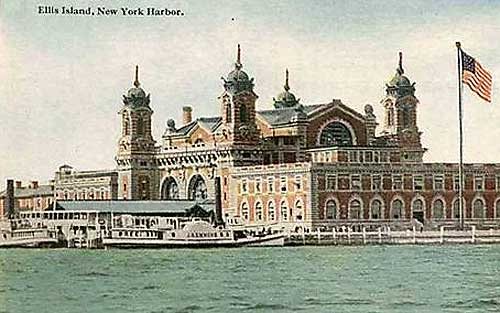
But Walt didn't always listen to Jules' suggestions. In
fact, Disney deliberately ignored Stein's advice when it came to the subject of
EPCOT. When Jules learned of Walt's plan to build a futuristic city as part of
his Florida Project, Stein immediately got Disney on the phone and told him
flat-out not to go ahead with that aspect of Disney World. That if the
bureaucratic red tape which Jules had to deal with on a daily basis because
Universal City had been incorporated were any indication, Walt was in for years
of headaches & heartache.
But as it turned out, Disney didn't have years. He had
months. And Stein … Well, while he tried to keep the lines of communication
open with Disney Studios after Walt died … To be blunt, Jules just didn't have the same sort of
long-term friendship / good working relationship with Roy O. that he did with
Walt. And when Disney's brother died in December of 1971 and Stein retired from
Universal in 1973, relations slowly began to deteriorate between the two
companies.
Mind you, Disney Studios and Universal Pictures could still occasionally work together. But only at times when one or more of these media giants felt
threatened. Take – for example – when Disney & Universal jointly sued Sony
in 1976. All because these two studios saw the Betamax video recorder as a
direct threat when it came to maintaining the long-term value of their film libraries.

Copyright Sony, Inc. All rights reserved
But perhaps the strangest times that Disney & Universal came
together was in 1984. Which was when the Mouse – as it found itself under attack from
greenmailers like Saul P. Steinberg & Irwin Jacobs – began searching for
safe harbors. Which – in this instance, anyway – meant quickly finding a way to make
Walt Disney Productions a far less attractive target for acquisition.
And one of the easiest ways to do this was by merging with a
competitor. In effect making Disney too big to buy. Which was what Ron Miller
& Card Walker were trying to do when they reached out to Lew Wasserman (who
was now Jules Stein's successor) and asking him if MCA / Universal would be
interested in acquiring Walt Disney Studios.
As Connie Bruck recounts in her 2003 book, "When Hollywood Had a King: The Reign of Lew Wasserman, Who Leveraged Talent into Power and Influence," Wasserman was interested in acquiring Disney. And this deal came within inches of actually happening. Only to then be derailed at virtually the last minute due to Lew's stubbornness:

Copyright Random House, Inc. All rights reserved
"All the terms were done," said Barry Diller, who
had learned what happened from one of the principals. "But the Disney
family said that Ron Miller [a Disney executive] had to be president. Sid
[Sheinberg] said to Lew, 'It's fine.' Felix [Rohatyn, the investment banker
advising MCA] said to Lew, 'Do it – a year from now, you'll get rid of Miller,
and make Sid President.' But Lew said 'No. Sidney is president.'
"It was Lew's inflexibility that caused him to blow
deals he should not have blown," Diller added. "He and Jules [Stein]
had built the best company – they should have owned the world. And had they
made this deal with Disney, everything would have been different."
Now contrast this with what happened just one year later
when Ron Miller was out and Michael Eisner was now in charge of the Mouse
House. Within three months of coming to power at Disney, Eisner announced that
Walt Disney World would soon be adding a studio tour to its already large
assortment of attractions.
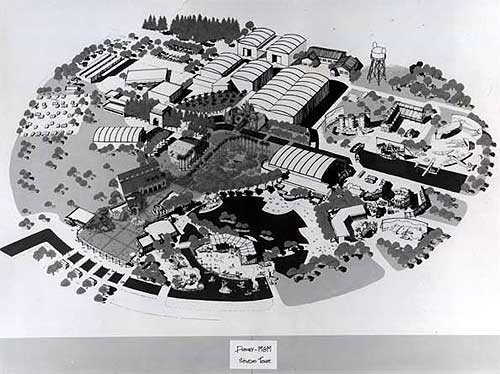
Concept art for the 1985 version of the Disney MGM Studio Tour. Copyright Disney
Enterprises, Inc. All rights reserved
"And why would this news upset the folks at Universal?," you
ask. Because – as I mentioned at the very top of this article – MCA / Universal
had been trying to get a clone of their Hollywood studio tour built in the Central Florida area ever since 1979. What's more,
Michael Eisner (while he was working at Paramount Pictures back in 1981) had
allegedly sat in on a meeting where Universal executives had gone into great
detail about the sort of theme park that they were planning on building in Orlando. So
the new head of Disney not only knew what the competition was planning on building, he knew how to top them.
Which is why Universal – for a while, anyway, in early 1985 –
took a "If you can't beat them, join them" approach. Executives from MCA / Universal
Studios Recreation Group actually reached to Disney and suggested that the two companies join forces on this studio tour project. Which (on paper, anyway) did make sense. Given
that Disney (at that time) didn't have a library full of films which would appeal to adults.
Whereas Universal did. More to the point, MCA / Universal had over 20 years of
experience at that point when it came to running a studio theme park
attraction. So the Imagineers could immediately tap into that expertise.
The way I hear it, Disney listened politely to Universal's
offer and then opted to go with MGM/UA instead. Mostly because MCA / Universal
was looking for some sort of on-going, royalty-based arrangement. Whereas MGM/UA would license
its name to Disney (more importantly, give WDI access to 250 titles in its film
library) for 20 years at a ridiculously low rate. Starting at $100,000 a year
and then slowly climbing to $1,000,000 in the final year of this licensing deal.
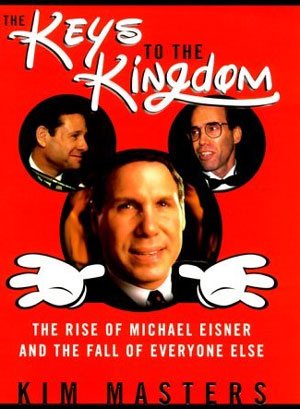
Copyright HarperCollins Publishers, Inc.
All rights reserved
"And how did Universal react to this news?," you query.
Well, as Kim Masters recounted in her 2000 book, "Keys to the Kingdom : The Rise of Michael Eisner and the Fall of Everybody Else," Sid Sheinberg (i.e. MCA/Universal's
then-president and COO) clearly missed the good old days when people like Jules
Stein & Walt Disney were the kings of Hollywood. When the competition
between studios was cordial, not quite so cutthroat.
In "Keys of the Kingdom," Masters quotes Sheinberg as saying
that the Disney studio tour attraction was " … a rip-off of a concept that we
worked hard to develop." More importantly, that "… Michael Eisner had been
exposed to a lot of very confidential information and knew (exactly) what our
plans were." But the crew at MCA / Universal ultimately wound up getting snookered by Disney because " … we
were trying to behave by a code of chivalry that I guess was out of date."
There's a lot of story still left to tell here, folks. Especially
when it comes to the brutal PR battle that erupted between Universal & Disney in
the mid-to-late 1980s when it came to who was building the best studio theme
park in Central Florida. More importantly, who stole the ideas for what attractions from whom.
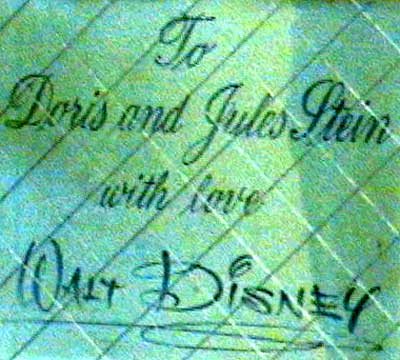
But rather than end things on a down note like that, I'd prefer to
circle back on a better time & place in our narrative. To be specific, the strong friendship / good working relationship that Jules
Stein & Walt Disney had (which is actually commemorated as part of that Mary
Blair-designed mural at the UCLA Eye
Center by the dedication tile depicted above). More importantly, the part that Walt played in the revival
of the Universal Studio Tour. Which can be directly traced back to those three
days that a certain 21 year-old spent exploring the magical movie kingdom which Universal City's backlot used to be back in the 1920s.
Which brings us now to the obvious question: Did Disneyland inspire the Universal Studio Tour in Hollywood? Or was it actually the other way around?
Your thoughts?
Editor's note: My apologies for JHM being a bit light on
content last week. But after that freak Nor'Easter, I initially thought that I'd be able to knock out this how-Walt-influenced-and-impacted-the-Universal-Studio-Tour
story in just a day or so. But six days later … Well, there's still a ton of
material that I wasn't able to fold in here. Which brings me to my question: Would you
guys be interested in more stories that look back on the Disney /
Universal theme park wars of the late 1980s / early 1990s? If so, please let me
know. And I'll then see if I break this "War And Peace" -length narrative into a more
Web-friendly format.
Theme Parks & Themed Entertainment
Disney and Macy’s 90-Year Thanksgiving Day Parade Partnership: From Mickey’s First Balloon to Minnie’s Big Debut

Now, folks, if you’re like me, Thanksgiving just wouldn’t be the same without a coffee, a cozy seat, and Macy’s Thanksgiving Day Parade on the TV. And if you’re really like me, you’re watching for one thing: Disney balloons floating down 34th Street. Ever wondered how Mickey, Donald, and soon Minnie Mouse found their way into this beloved New York tradition? Well, grab your popcorn because we’re diving into nearly 90 years of Disney’s partnership with Macy’s.
The Very First Parade and the Early Days of Balloons
The Macy’s Thanksgiving Day Parade goes way back to 1924, but if you can believe it, balloons weren’t part of the festivities until 1927. That first lineup included Felix the Cat, a dragon, and a toy soldier, all towering above the crowds. Back then, Macy’s had a pretty wild idea to end the parade: they would let the balloons drift off into the sky, free as birds. But this wasn’t just Macy’s feeling generous. Each balloon had a message attached, offering a $100 reward (about $1,800 in today’s dollars) for anyone who returned it to the flagship store on 34th Street.
And here’s where it gets interesting. This tradition carried on for a few years, right up until 1932, when Felix the Cat almost took down a plane flying over New York City! Imagine that—you’re flying into LaGuardia, and suddenly, there’s a 60-foot balloon drifting toward your wing. Needless to say, that was the end of Macy’s “fly away” stunt, and from then on, the balloons have stayed firmly grounded after the parade ends.

1934: Mickey Mouse Floats In, and Disney Joins the Parade
It was 1934 when Mickey Mouse finally made his grand debut in the Macy’s parade. Rumor has it Walt Disney himself collaborated with Macy’s on the design, and by today’s standards, that first Mickey balloon was a bit of a rough cut. This early Mickey had a hotdog-shaped body, and those oversized ears gave him a slightly lopsided look. But no one seemed to mind. Mickey was there, larger than life, floating down the streets of New York, and the crowd loved him.
Mickey wasn’t alone that year. He was joined by Pluto, Horace Horsecollar, and even the Big Bad Wolf and Practical Pig from The Three Little Pigs, making it a full Disney lineup for the first time. Back then, Disney wasn’t yet the entertainment powerhouse we know today, so for Walt, getting these characters in the parade meant making a deal. Macy’s required its star logo to be featured on each Disney balloon—a small concession that set the stage for Disney’s long-standing presence in the parade.
Duck Joins and Towers Over Mickey
A year later, in 1935, Macy’s introduced Donald Duck to the lineup, and here’s where things got interesting. Mickey may have been the first Disney character to float through the parade, but Donald made a huge splash—literally. His balloon was an enormous 60 feet tall and 65 feet long, towering over Mickey’s 40-foot frame. Donald quickly became a fan favorite, appearing in the lineup for several years before being retired.
Fast-forward a few decades, and Donald was back for a special appearance in 1984 to celebrate his 50th birthday. Macy’s dug the balloon out of storage, re-inflated it, and sent Donald down 34th Street once again, bringing a bit of nostalgia to the holiday crowd.
A Somber Parade in 2001
Now, one of my most memorable trips to the parade was in 2001, just weeks after the 9/11 attacks. Nancy and I, along with our friends, headed down to New York, and the mood was something I’ll never forget. We watched the start of the parade from Central Park West, but before that, we went to the Museum of Natural History the night before to see the balloons being inflated. They were covered in massive cargo nets, with sandbags holding them down. It’s surreal to see these enormous balloons anchored down before they’re set free.
That year, security was intense, with police lining the streets, and then-Mayor Rudy Giuliani rode on the Big Apple float to roaring applause. People cheered his name, waving and shouting as he passed. It felt like the entire city had turned out to show their resilience. Even amidst all the heightened security and tension, seeing those balloons—brought a bit of joy back to the city.

Balloon Prep: From New Jersey’s MetLife Stadium to California’s D23 Expo
Each year before the parade, Macy’s holds a rehearsal event known as Balloon Fest at MetLife Stadium in New Jersey. This is where handlers get their first crack at guiding the balloons, practicing with their parade masters, and learning the ropes—literally. It’s an entire production unto itself, with dozens of people rehearsing to make sure these enormous inflatables glide smoothly down the streets of New York on parade day.
In 2015, Macy’s took the balloon show on the road, bringing their Buzz Lightyear balloon out to California for the D23 Expo. I was lucky enough to be there, and watching Buzz get inflated piece by piece in the Anaheim Convention Center parking lot was something to behold. Each section was filled with helium in stages, and when they got around to Buzz’s lower half, well, there were more than a few gas-related jokes from the crowd.
These balloons seem to have a personality all their own, and seeing one like Buzz come to life up close—even outside of New York—had all the excitement and anticipation of the real deal.

Mickey’s Comeback as a Bandleader and Sailor Mickey
After a long hiatus, Mickey Mouse made his return to the Macy’s parade in 2000, this time sporting a new bandleader outfit. Nine years later, in 2009, Sailor Mickey joined the lineup, promoting Disney Cruise Line with a nautical twist. Over the past two decades, Disney has continued to enchant parade-goers with characters like Buzz Lightyear in 2008 and Olaf from Frozen in 2017. These balloons keep Disney’s iconic characters front and center, drawing in both longtime fans and new viewers.
But ever wonder what happens to the balloons after they reach the end of 34th Street? They don’t just disappear. Each balloon is carefully deflated, rolled up like a massive piece of laundry, and packed into storage bins. From there, they’re carted back through the Lincoln Tunnel to Macy’s Parade Studio in New Jersey, where they await their next flight.

Macy’s Disney Celebration at Hollywood Studios
In 1992, Macy’s took the spirit of the parade down to Disney-MGM Studios in Orlando. After that year’s parade, several balloons—including Santa Goofy, Kermit the Frog, and Betty Boop—were transported to Hollywood Studios, re-inflated, and anchored along New York Street as part of a holiday display. Visitors could walk through this “Macy’s New York Christmas” setup and see the balloons up close, right in the middle of the park. While this display only ran for one season, it paved the way for the Osborne Family Spectacle of Dancing Lights, which became a holiday staple at the park for years to come.

Minnie Mouse’s Long-Awaited Debut in 2024
This year, Minnie Mouse will finally join the parade, making her long-overdue debut. Macy’s is rolling out the red carpet for Minnie’s arrival with special pop-up shops across the country, where fans can find exclusive Minnie ears, blown-glass ornaments, T-shirts, and more to celebrate her first appearance in the Thanksgiving Day Parade.

For those lucky enough to catch the parade this year, you’ll see Minnie take her first float down 34th Street, decked out in her iconic red bow and polka-dot dress. Macy’s and Disney are also unveiling a new Disney Cruise Line float honoring all eight ships, including the latest, the Disney Treasure.
As always, I’ll be watching from my favorite chair, coffee in hand, as Minnie makes her grand entrance. The 98th annual Macy’s Thanksgiving Day Parade airs live on NBC, and it’s a tradition you won’t want to miss—whether you’re on 34th Street or tuning in from home.
Theme Parks & Themed Entertainment
Disney’s Forgotten Halloween Event: The Original Little Monsters on Main Street

When most Disney fans think of Halloween in the parks, they immediately picture Mickey’s Not-So-Scary Halloween Party at Walt Disney World or the Oogie Boogie Bash at Disneyland Resort. But before those events took over as the must-attend spooky celebrations, there was a little-known event at Disneyland called Little Monsters on Main Street. And its origins? Well, they go all the way back to the 1980s, during a time when America was gripped by fear—the Satanic Panic.

You see, back in the mid-1980s, parents were terrified that Halloween had become dangerous. Urban legends about drug-laced candy or razor blades hidden in apples were widespread, and many parents felt they couldn’t let their kids out of sight for even a moment. Halloween, which was once a carefree evening of trick-or-treating in the neighborhood, had suddenly become a night filled with anxiety.
This is where Disneyland’s Little Monsters on Main Street came in.

The Origins of Little Monsters on Main Street
Back in 1989, the Disneyland Community Action Team—later known as the VoluntEARS—decided to create a safe, nostalgic Halloween experience for Cast Members and their families. Many schools in the Anaheim area were struggling to provide basic school supplies to students, and the VoluntEARS saw an opportunity to combine a safe Halloween with a charitable cause. Thus, Little Monsters on Main Street was born.
This event was not open to the general public. Only Disneyland Cast Members could purchase tickets, which were initially priced at just $5 each. Cast Members could bring their kids—but only as many as were listed as dependents with HR. And even then, the park put a cap on attendance: the first event was limited to just 1,000 children.

A Unique Halloween Experience
Little Monsters on Main Street wasn’t just another Halloween party. It was designed to give kids a safe, fun environment to enjoy trick-or-treating, much like the good old days. On Halloween night in 1989, kids in costume wandered through Disneyland with their pillowcases, visiting 20 different trick-or-treat stations. They also had the chance to ride a few of their favorite Fantasyland attractions, all after the park had closed to the general public.
The event was run entirely by the VoluntEARS—about 200 of them—who built and set up all the trick-or-treat stations themselves. They arrived at Disneyland before the park closed and, as soon as the last guest exited, they began setting up stations across Main Street, Adventureland, Frontierland, Fantasyland, and Tomorrowland. The event ran from 7:30 to 9:30 p.m., and by the time the last pillowcase-wielding kid left, the VoluntEARS cleaned everything up, making sure the park was ready for the next day’s operations.
It wasn’t just candy and rides, though. The event featured unique entertainment, like a Masquerade Parade down Main Street, U.S.A., where kids could show off their costumes. And get this—Disneyland even rigged up a Cast Member dressed as a witch to fly from the top of the Matterhorn to Frontierland on the same wire that Tinker Bell uses during the fireworks. Talk about a magical Halloween experience!
The Haunted Mansion “Tip-Toe” Tour
Perhaps one of the most memorable parts of Little Monsters on Main Street was the special “tip-toe tour” of the Haunted Mansion. Now, Disneyland’s Haunted Mansion can be a pretty scary attraction for younger kids, so during this event, Disney left the doors to the Stretching Room and Portrait Gallery wide open. This allowed kids to walk through and peek at the Haunted Mansion’s spooky interiors without actually having to board the Doom Buggies. For those brave enough to ride, they could, of course, take the full trip through the Haunted Mansion—or they could take the “chicken exit” and leave, no harm done.

Growing Success and a Bigger Event
Thanks to the event’s early success, Little Monsters on Main Street grew in size. By 1991, the attendance cap had been raised to 2,000 kids, and Disneyland added more activities like magic shows and hayrides. They also extended the event’s hours, allowing kids to enjoy the festivities until 10:30 p.m.
In 2002, the event moved over to Disney California Adventure, where it could accommodate even more kids—up to 5,000 in its later years. The name was also shortened to just Little Monsters, since it was no longer held on Main Street. This safe, family-friendly Halloween event continued for several more years, with the last mention of Little Monsters appearing in the Disneyland employee newsletter in 2008. Though some Cast Members recall the event continuing until 2012, it eventually made way for Disney’s more public-facing Halloween events.

From Little Monsters to Mickey’s Not-So-Scary and Oogie Boogie Bash
Starting in the early 2000s, Disney began realizing the potential of Halloween-themed after-hours events for the general public. These early versions of Mickey’s Halloween Party and Mickey’s Halloween Treat eventually evolved into today’s Mickey’s Not-So-Scary Halloween Party and Oogie Boogie Bash. Unfortunately, this also marked the end of the intimate, Cast Member-exclusive Little Monsters event, but it paved the way for the large-scale Halloween celebrations we know and love today.
While it’s bittersweet to see Little Monsters on Main Street fade into Disney history, its legacy lives on through these modern Halloween parties. And even though Cast Members now receive discounted tickets to Mickey’s Not-So-Scary and Oogie Boogie Bash, the special charm of an event created specifically for Disney’s employees and their families remains something worth remembering.
The Merch: A Piece of Little Monsters History
For Disney collectors, the exclusive merchandise created for Little Monsters on Main Street is still out there. You can find pins, name tags, and themed pillowcases on sites like eBay. One of the coolest collectibles is a 1997 cloisonné pin set featuring Huey, Dewey, and Louie dressed as characters from Hercules. Other sets paid tribute to the Main Street Electrical Parade and Pocahontas, while the pillowcases were uniquely designed for each year of the event.

While Little Monsters on Main Street may be gone, it’s a fascinating piece of Disneyland history that played a huge role in shaping the Halloween celebrations we enjoy at Disney parks today.
Want to hear more behind-the-scenes stories like this? Be sure to check out I Want That Too, where Lauren and I dive deep into the history behind Disney’s most beloved attractions, events, and of course, merchandise!
Theme Parks & Themed Entertainment
The Story of Mickey’s Not-So-Scary Halloween Party: From One Night to a Halloween Family Tradition

The spooky season is already in full swing at Disney parks on both coasts. On August 9th, the first of 38 Mickey’s Not-So-Scary Halloween Party (MNSSHP) nights for 2024 kicked off at Florida’s Magic Kingdom. Meanwhile, over at Disney California Adventure, the Oogie Boogie Bash began on August 23rd and is completely sold out across its 27 dates this year.
Looking back, it’s incredible to think about how these Halloween-themed events have grown. But for Disney, the idea of charging guests for Halloween fun wasn’t always a given. In fact, when the very first Mickey’s Not-So-Scary Halloween Party debuted on October 31, 1995, it was a modest one-night-only affair. Compare that to the near month-long festivities we see today, and it’s clear that Disney’s approach to Halloween has evolved considerably.
A Not-So-Scary Beginning
I was fortunate enough to attend that very first MNSSHP back in 1995, along with my then 18-month-old daughter Alice and her mom, Michelle. Tickets were a mere $16.95 (I know, can you imagine?), and we pushed Alice around in her sturdy Emmaljunga stroller—Swedish-built and about the size of a small car. Cast Members, charmed by her cuteness, absolutely loaded us up with candy. By the end of the night, we had about 30 pounds of fun-sized candy bars, making that push up to the monorail a bit more challenging.

This Halloween event was Disney’s response to the growing popularity of Universal Studios Florida’s own Halloween hard ticket event, which started in 1991 as “Fright Nights” before being rebranded as “Halloween Horror Nights” the following year. Universal’s gamble on a horror-themed experience helped salvage what had been a shaky opening for their park, and by 1993, Halloween Horror Nights was a seven-night event, with ticket prices climbing as high as $35. Universal had stumbled upon a goldmine, and Disney took notice.
A Different Approach
Now, here’s where Disney’s unique strategy comes into play. While Universal embraced the gory, scare-filled world of horror, Disney knew that wasn’t their brand. Instead of competing directly with blood and jump-scares, Disney leaned into what they did best: creating magical, family-friendly experiences.
Thus, Mickey’s Not-So-Scary Halloween Party was born. The focus was on fun and whimsy, not fear. Families could bring their small children without worrying about them being terrified by a chainsaw-wielding maniac around the next corner. This event wasn’t just a Halloween party—it was an extension of the Disney magic that guests had come to expect from the parks.
Disney had some experience with seasonal after-hours events, most notably Mickey’s Very Merry Christmas Party, which had started in 1983. But the Halloween party was different, as the Magic Kingdom wasn’t yet decked out in Halloween decor the way it is today. Disney had to create a spooky (but not too spooky) atmosphere using temporary props, fog machines, and, of course, lots of candy.
A key addition to that first event? The debut of the Headless Horseman, who made his eerie appearance in Liberty Square, riding a massive black Percheron. It wasn’t as elaborate as the Boo-to-You Parade we see today, but it marked the beginning of a beloved Disney Halloween tradition.
A Modest Start but a Big Future
That first MNSSHP in 1995 was seen as a trial run. As Disney World spokesman Greg Albrecht told the Orlando Sentinel, “If it’s successful, we’ll do it again.” And while attendance was sparse that night, there was clearly potential. By 1997, the event expanded to two nights, and by 1999, Mickey’s Not-So-Scary Halloween Party had grown into a multi-night celebration with a full-fledged parade. Today, in 2024, it’s a staple of the fall season at Walt Disney World, offering 38 nights of trick-or-treating, character meet-and-greets, and special entertainment.
Universal’s Influence

It’s interesting to reflect on how Disney’s Halloween event might never have existed without the competition from Universal. Just as “The Wizarding World of Harry Potter” forced Disney to step up their game with “Star Wars: Galaxy’s Edge,” Universal’s success with Halloween Horror Nights likely spurred Disney into action with MNSSHP. The friendly rivalry between the two parks has continually pushed both to offer more to their guests, and we’re all better off because of it.
So the next time you find yourself trick-or-treating through the Magic Kingdom, watching the Headless Horseman gallop by, or marveling at the seasonal fireworks, take a moment to appreciate how this delightful tradition came to be—all thanks to a little competition and Disney’s commitment to creating not-so-scary magic.
For more Disney history and behind-the-scenes stories, check out the latest episodes of the I Want That Too podcast on the Jim Hill Media network.
-

 History10 months ago
History10 months agoThe Evolution and History of Mickey’s ToonTown
-

 History11 months ago
History11 months agoUnpacking the History of the Pixar Place Hotel
-

 History11 months ago
History11 months agoFrom Birthday Wishes to Toontown Dreams: How Toontown Came to Be
-

 Film & Movies8 months ago
Film & Movies8 months agoHow Disney’s “Bambi” led to the creation of Smokey Bear
-

 News & Press Releases10 months ago
News & Press Releases10 months agoNew Updates and Exclusive Content from Jim Hill Media: Disney, Universal, and More
-

 Merchandise8 months ago
Merchandise8 months agoIntroducing “I Want That Too” – The Ultimate Disney Merchandise Podcast
-

 Theme Parks & Themed Entertainment3 months ago
Theme Parks & Themed Entertainment3 months agoDisney’s Forgotten Halloween Event: The Original Little Monsters on Main Street
-

 Film & Movies3 months ago
Film & Movies3 months agoHow “An American Tail” Led to Disney’s “Hocus Pocus”








